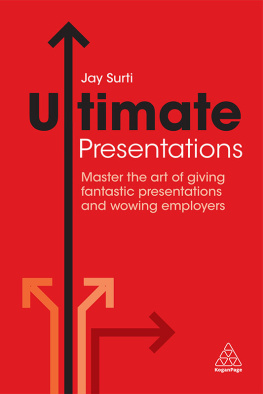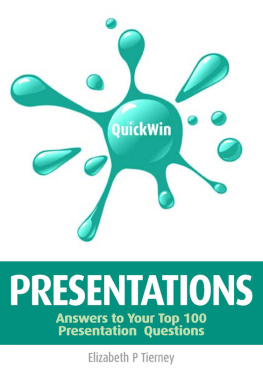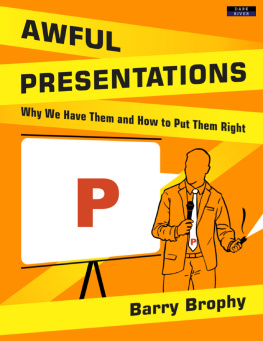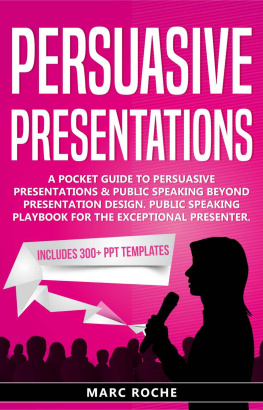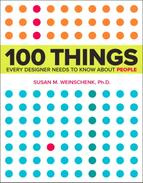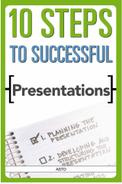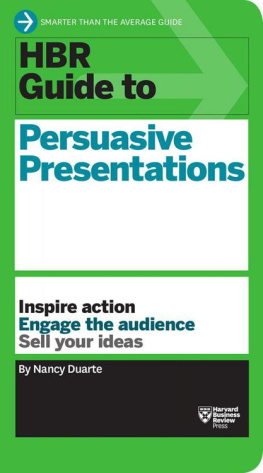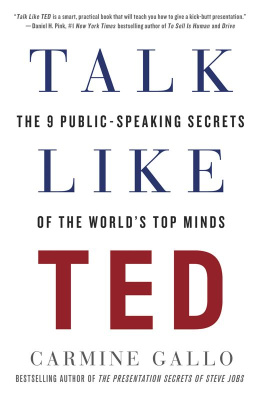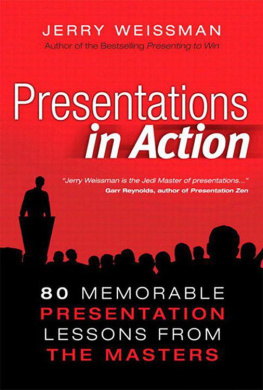100 Things
Every Presenter Needs to Know About People
Susan Weinschenk, Ph.D.
100 Things Every Presenter Needs to Know About People
Susan Weinschenk, Ph.D.
New Riders
1249 Eighth Street
Berkeley, CA 94710
510/524-2178
510/524-2221 (fax)
Find us on the Web at www.newriders.com
To report errors, please send a note to
New Riders is an imprint of Peachpit, a division of Pearson Education
Copyright 2012 by Susan Weinschenk, Ph.D.
Acquisitions Editor: Michael J. Nolan
Project Editor: Valerie Witte
Production Editor: Tracey Croom
Development Editor: Jeff Riley
Copyeditor: Scout Festa
Indexer: Rebecca Plunkett
Proofreader: Liz Welch
Cover Designer: Mimi Heft
Composition and Interior Design: Maureen Forys, Happenstance Type-O-Rama
Notice of Rights
All rights reserved. No part of this book may be reproduced or transmitted in any form by any means, electronic, mechanical, photocopying, recording, or otherwise, without the prior written permission of the publisher. For information on getting permission for reprints and excerpts, contact .
Notice of Liability
The information in this book is distributed on an As Is basis, without warranty. While every precaution has been taken in the preparation of the book, neither the author nor Peachpit shall have any liability to any person or entity with respect to any loss or damage caused or alleged to be caused directly or indirectly by the instructions contained in this book or by the computer software and hardware products described in it.
Trademarks
Many of the designations used by manufacturers and sellers to distinguish their products are claimed as trademarks. Where those designations appear in this book, and Peachpit was aware of a trademark claim, the designations appear as requested by the owner of the trademark. All other product names and services identified throughout this book are used in editorial fashion only and for the benefit of such companies with no intention of infringement of the trademark. No such use, or the use of any trade name, is intended to convey endorsement or other affiliation with this book.
ISBN 13: 978-0-321-82124-9
ISBN 10: 0-321-82124-6
9 8 7 6 5 4 3 2 1
Printed and bound in the United States of America
Acknowledgments
This book is made possible by all the people who have come to my speeches, presentations, and classes over many years. Thanks for helping me learn how to be a better presenter and thanks for the opportunity to experiment with new ideas.
Thanks to Michael Nolan at New Riders for helping me decide on the topic of this book, and thanks to Valerie Witte for taking me on as her author. This is the third book that Ive had the pleasure of working on with Jeff Riley, my development editor. He is the one who gets me to see the places where my ideas, writing, and approach are weak. He gently pushes until I make the changes that mean the reader will have a great experience. The before Jeff book is really different from the after Jeff book. We work well together, and maybe someday Ill actually get to meet him in person!
Dedication
This book is dedicated to my family, who endure my endless talking about whichever book Im working on, who put up with my habit of moving from room to room as I write, and who allow me to give up weekends and holiday events because I have to work on a chapter. Your support keeps me going!
How to Use Psychology to Be a Better Presenter
There are always three speeches for every one you actually gave: the one you practiced, the one you gave, and the one you wish you gave.
Dale Carnegie
Which of the following is true of you:
A. After you give a presentation, you usually feel that it was quite successful.
B. After you give a presentation, you are usually tormented by all the things you should have done or said differently.
If your answer was A, then this book might not be for you. Not because you are already a great presenter, but because you might not be motivated enough to learn what you need to know about people to be a better presenter.
Ive given hundreds of presentations in my career, and Im a popular speaker. People say things like, That was the best presentation Ive ever attended. And Im grateful for these kind words. But Im never satisfied. Although I usually think that there were several aspects of the just-completed presentation that were quite good, I am my own worst critic. Maybe Im too hard on myself. All I know is that practically before the presentation is done, Ive already identified what to change.
Sometimes when Im coaching people on presentation skills they will say something like, Im not a great presenter. I dont know if Ill ever be a great presenter. Im never satisfied with the presentations I give. Thats good, I respond, now I know that you have the capability of being a great presenter. Like any great artist or performer, great presenters are constantly striving to improve their performance and their craft.
In his book Drive, Daniel Pink talks about the research on motivation and mastery. People are motivated to master a topic or skill. The drive for mastery keeps us working at a task. But, according to Pink, mastery can never be reachedit can really only be approached.
Every day around the world millions of presentations are delivered. Some are great, some are mediocre, and some are just downright boring. How much better would the world be, how much more inspired would your audiences be, and how much change could you make in the world if you improved the quality of your presentations?
There are two sides to every presentation. You are speaking, but an audience is listening. If you want to give a great presentation, you need to know a lot about people. The more you understand how people think, learn, hear, see, react, and decide, the better able you will be to put together a presentation that informs, inspires, and motivates. When you learn about others, youll know how to craft and deliver a powerful presentation.
How People Think and Learn
I never teach my pupils; I only attempt to provide the conditions in which they can learn.
Albert Einstein
If you want to communicate with people effectively and persuasively, then you need to understand how people think, filter information, and learn. Its not a matter of handing them information; if you want people to remember, act on, and use what you are communicating, then you need to present the information in a way that matches how people think and how people learn.
1. People Process Information Better In Bite-Sized Chunks
The brain can process only a small amount of information at a timeconsciously, that is. (The estimate is that you handle 40 billion pieces of information every second but that only 40 of those make it to your conscious brain.) One mistake that presenters make is giving too much information all at once.
Use Progressive Disclosure
Progressive disclosure means providing only the information people need at the moment.
At one presentation I attended, the presenter was giving a demonstration of tax accounting software to tax accountants. If she had been using progressive disclosure, she would have given a high-level demonstration from beginning to end and then gone back to fill in the details. Instead, she gave an exhaustive description of step one. Before she even got to step two, everyones eyes had glazed over. It was too much detail too fast.



